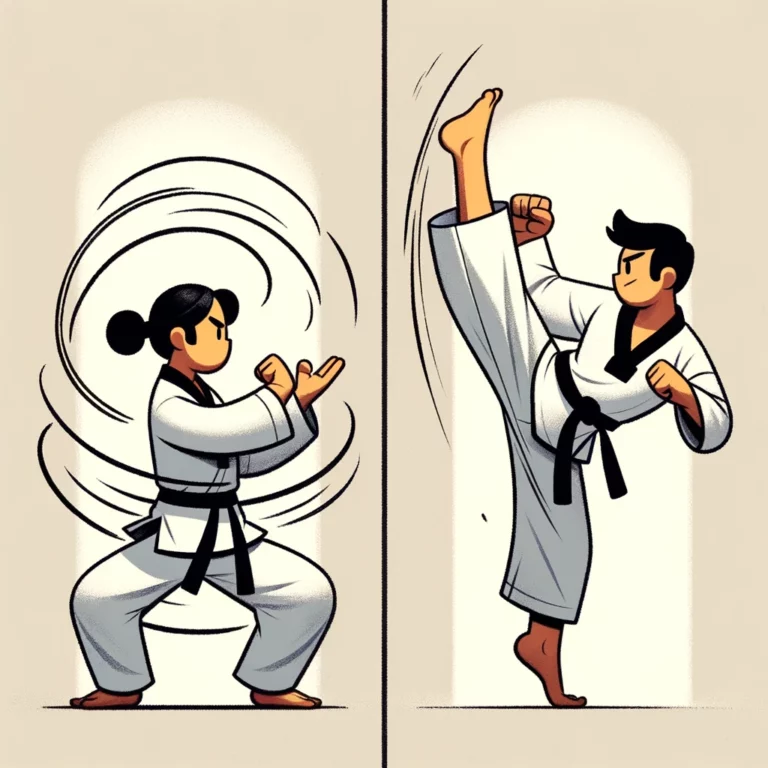Are you curious about what earning a white belt in Tae Kwon Do takes? This article will cover everything you need to know about the significance of the white belt, its history, the requirements and techniques for earning it, and the benefits of achieving this milestone.
We will also explore how long it typically takes to earn a white belt and what comes next in the Tae Kwon Do belt system. Whether you’re a beginner or simply interested in martial arts, this article will provide valuable insights to help you improve your skills in Tae Kwon Do.
What Is Tae Kwon Do?
Tae Kwon Do, originating from Korea, is a traditional Korean martial art that focuses on training individuals in self-defence, discipline, and respect through a structured set of techniques and forms.
Tae Kwon Do has a history of over 2,000 years and is deeply rooted in Korean culture. It promotes the philosophy of non-violence and self-control, emphasising the unity of mind, body, and spirit.
The fundamental principles of Tae Kwon Do include courtesy, integrity, perseverance, self-control, and an indomitable spirit. Its training methods involve rigorous physical conditioning, sparring, and forms to develop strength, flexibility, and mental focus.
With its emphasis on respect and humility, Tae Kwon Do teaches self-defence and fosters personal growth and character development.

What does a white belt mean in Tae Kwon Do?
The white belt in Tae Kwon Do holds immense symbolism, signifying the beginning of a practitioner’s journey, as it represents purity, humility, and the commitment to learning the foundational skills of the art.
This novice rank is a powerful reminder of the core principles of Tae Kwon Do, emphasising the importance of discipline, respect, and patience in mastering this martial art.
It is a visual representation of a blank canvas, symbolising the potential for growth and development in both technique and character. As beginners embark on their path, the white belt encourages them to approach their training with an open mind and a willingness to absorb knowledge from instructors and fellow students. It fosters an understanding that progress is achieved through perseverance and continuous effort, laying the groundwork for advancement within the belt system.
What Is the History of the White Belt in Tae Kwon Do?
The history of the white belt in Tae Kwon Do traces back to the traditional roots of Korean martial arts. It symbolises the initial stage of a student’s journey in mastering the art’s foundational techniques and embracing its cultural heritage.
This belt, often associated with humility and purity, reflects the time-honoured customs of the ancient martial arts. In these traditions, novices were distinguishable by their white attire. As students progress in training, they advance through the coloured belt system. Each belt represents a deeper understanding of the art and its principles.
Through this progression, practitioners refine their physical skills and develop mental fortitude and a deeper appreciation for the art’s historical significance. This journey symbolises the growth and development of the individual, both as a martial artist and as a person.

What Are the Requirements for White Belt in Tae Kwon Do?
Earning a white belt in Tae Kwon Do necessitates adherence to specific requirements, including demonstrating fundamental techniques, showcasing respect and etiquette, and undergoing formal testing by a qualified instructor.
Throughout the training process, practitioners are encouraged to embody the core values of Tae Kwon Do, such as perseverance, indomitable spirit, and self-discipline.
Instructors play a pivotal role in guiding students through the art’s intricacies, imparting physical skills and instilling the mental fortitude required for progression.
Students must familiarise themselves with the code of conduct and etiquette, emphasising humility, courtesy, and integrity, forming the foundation for a respectful and disciplined martial arts journey.
What Are the Basic Techniques for White Belt in Tae Kwon Do?
The basic techniques for white belt practitioners in Tae Kwon Do encompass fundamental stances, strikes, and blocks, laying the groundwork for developing essential skills and knowledge vital to their training and progression.
These foundational techniques are the building blocks for a student’s journey in Tae Kwon Do.
Mastery of basic stances like the horse stance and front stance instils balance and stability while learning strikes such as the front kick and roundhouse kick hones precision and power.
Understanding and applying high and low blocks are integral for defensive capabilities.
Developing proficiency in these techniques creates a solid foundation and cultivates discipline, focus, and respect in white belt practitioners.
What are the forms for a white belt in Tae Kwon Do?
The forms tailored for white belt practitioners in Tae Kwon Do serve as structured sequences of movements, integrating fundamental techniques and positional transitions, essential for honing their foundational skills and fostering discipline.
Carefully crafted for beginners, these forms are pivotal in guiding white belt practitioners through footwork, stance, and striking techniques. They provide a systematic approach to learning and mastering the basics, promoting muscle memory and coordination.
These forms instil the values of patience and perseverance as practitioners strive to perfect each movement, laying a solid foundation for their journey in Tae Kwon Do.
What Are the Benefits of Earning a White Belt in Tae Kwon Do?
Earning a white belt in Tae Kwon Do bestows many benefits, encompassing physical conditioning, mental fortitude, and social growth, fostering continual advancement and self-improvement.
The physical benefits of earning a white belt include improved flexibility, strength, and coordination. Mentally, it instils discipline, focus, and the ability to overcome challenges. Socially, it provides opportunities to connect with a community of practitioners, fostering teamwork and camaraderie.
Attaining a white belt in Tae Kwon Do equips individuals with essential life skills and sets the foundation for progression in this martial art.
Physical Benefits
The journey towards a white belt in Tae Kwon Do cultivates physical benefits such as improved self-defence skills, heightened confidence, enhanced coordination, agility, and strength, empowering practitioners with a robust physical foundation.
Tae Kwon Do offers numerous physical benefits due to its rigorous training regime. This includes developing powerful kicks, swift strikes, and efficient defensive manoeuvres.
As beginners progress, they can expect to see improvements in flexibility, balance, and overall physical conditioning. The consistent practice of Tae Kwon Do forms and techniques also increases core strength and muscle tone.
These physical attributes allow practitioners to defend themselves effectively and contribute to their overall physical well-being.
Mental Benefits
Earning a white belt in Tae Kwon Do fosters significant mental benefits, instilling discipline, humility, perseverance, and dedication, shaping individuals into resilient and focused practitioners.
This early mastery stage sets the foundation for a strong mindset, encouraging practitioners to embrace the values of hard work and respect.
Earning a white belt requires commitment and resilience, fostering mental fortitude and a sense of achievement. By internalising the principles of discipline and dedication, individuals develop a deeper understanding of their capabilities and potential for growth, enhancing their mental strength and self-confidence.
Social Benefits
The attainment of a white belt in Tae Kwon Do fosters social benefits, including the embodiment of respect and honour and the preservation of Korean martial arts tradition, contributing to a sense of communal unity and mutual respect.
Embarking on the journey to earn a white belt signifies a commitment to the values and ethics upheld by the Tae Kwon Do community. It instils a deep understanding of discipline and integrity, which are integral to the practice of this martial art.
It promotes humility and perseverance, characteristics that are admired in both the martial arts world and broader society. This fosters a positive collective environment, encouraging individuals to support and uplift one another, establishing strong camaraderie and mutual encouragement bonds.
How long does earn a white belt in Tae Kwon Do take?
The duration to earn a white belt in Tae Kwon Do varies based on individual progression, commitment to continuing education, and mastery of foundational skills. This timeline is influenced by dedicated practice and skill development.
Recognising that each student’s journey to achieving a white belt can differ significantly is essential. Factors such as prior experience in martial arts, physical fitness, and the ability to grasp and apply techniques are crucial in determining the time frame.
Whilst some may attain the white belt relatively quickly, others may require more time and effort to reach the same level. Consistent and focused practice and a solid dedication to mastering the fundamental principles of Tae Kwon Do are essential for the progression and eventual attainment of the white belt.
Factors Affecting the Time to Earn a White Belt
Several factors influence the time required to earn a white belt in Tae Kwon Do, including the intensity of training, individual commitment, and the achievement of essential skills and knowledge necessary for advancement.
Training intensity plays a crucial role in mastering the required techniques and forms. Consistent and focused practice is essential to build strength, flexibility, and muscle memory.
Individual commitment is a significant factor – the willingness to practise regularly, attend classes, and apply oneself wholeheartedly to the learning process. A key milestone in the journey to a white belt is mastering basic kicks, punches, and stances, as well as understanding the fundamental principles and philosophy of Tae Kwon Do.
What comes after the white belt in Tae Kwon Do?
After the white belt, practitioners progress through a series of coloured belts, signifying advancements in skill and knowledge, with each belt colour representing a stage of progression within Tae Kwon Do’s structured advancement system.
Students demonstrate a deeper understanding of the basic techniques and principles starting with the yellow belt.
They develop more complex combinations and a stronger sense of control and precision as they progress to the green belt.
The blue belt marks an advancement in sparring techniques and strategic thinking.
Upon reaching the red belt, practitioners display high proficiency and discipline, preparing to achieve the coveted black belt.
What Are the Other Belt Colours in Tae Kwon Do?
Tae Kwon Do encompasses a spectrum of belt colours beyond the white belt, each denoting increased rank, symbolising advancement, and often celebrated through formal ceremonies that mark a practitioner’s progression within the art.
The progression through the various belt colours is essential in Tae Kwon Do, signifying the practitioner’s growth and proficiency. Each colour holds deep symbolism, from the yellow belt representing the dawning of new skills to the black belt embodying mastery.
The ceremonial aspect of transitioning to a new belt colour often involves rigorous testing, demonstrating proficiency and dedication to the discipline. This ceremonious transition further instils a deep sense of accomplishment and motivates practitioners to continue their training with renewed vigour.
What Are the Requirements for Advancing to the Next Belt?
Advancing to the next belt in Tae Kwon Do necessitates meeting specific requirements, encompassing the mastery of techniques, successful testing, and the guidance and approval of a qualified instructor, ensuring readiness for progression.
This process starts with mastering fundamental techniques, including strikes, blocks, and forms. These techniques provide a strong foundation for the higher belt level.
Successful testing involves demonstrating proficiency in these techniques and showcasing discipline, focus, and respect for the art. The instructor serves as a mentor, guiding students to refine their skills, instilling the principles of Tae Kwon Do, and evaluating their overall readiness for advancement.
How can someone improve their skills as a White Belt in Tae Kwon Do?
Enhancing skills as a white belt in Tae Kwon Do entails dedicated practice, unwavering discipline, and a steadfast commitment to continual improvement, fostering the mastery of foundational techniques and the development of a solid martial arts foundation.
Consistent training sessions offer numerous benefits for white belt practitioners. They can refine techniques, improve physical fitness, and strengthen mental discipline. With regular practice, fundamental movements become internalised, agility is cultivated, and a deeper understanding of the art is gained.
The unwavering commitment to self-improvement nurtures resilience, patience, and a growth mindset. These qualities are essential in Tae Kwon Do and daily life, creating a holistic approach to personal development.

Frequently Asked Questions
What does white belt mean in Tae Kwon Do?
The white belt is the first rank in Tae Kwon Do and symbolises a beginner level of training and understanding in the martial art.
What is the significance of the white belt in Tae Kwon Do?
The white belt represents a clean slate and the willingness to learn and improve. It also symbolises the start of the Tae Kwon Do journey and the foundation for future progress.
How long does earn a white belt in Tae Kwon Do take?
The time it takes to earn a white belt varies depending on the individual’s dedication and training. On average, achieving the white belt rank can take 2-3 months of consistent practice.
What basic techniques are taught at the white belt level in Tae Kwon Do?
At the white belt level, students learn the basic kicks, punches, and stances of Tae Kwon Do. They also begin to develop their balance, coordination, and focus.
Can you advance to a higher rank from a white belt in Tae Kwon Do?
Yes, the white belt is the starting point for a student’s journey in Tae Kwon Do, and they can progress to higher ranks through consistent practice, dedication, and passing rank tests.
Is it possible to skip the white belt rank in Tae Kwon Do?
No, the white belt rank is essential for building a solid foundation and understanding of Tae Kwon Do techniques. Skipping this rank may hinder a student’s progress in the long run.







